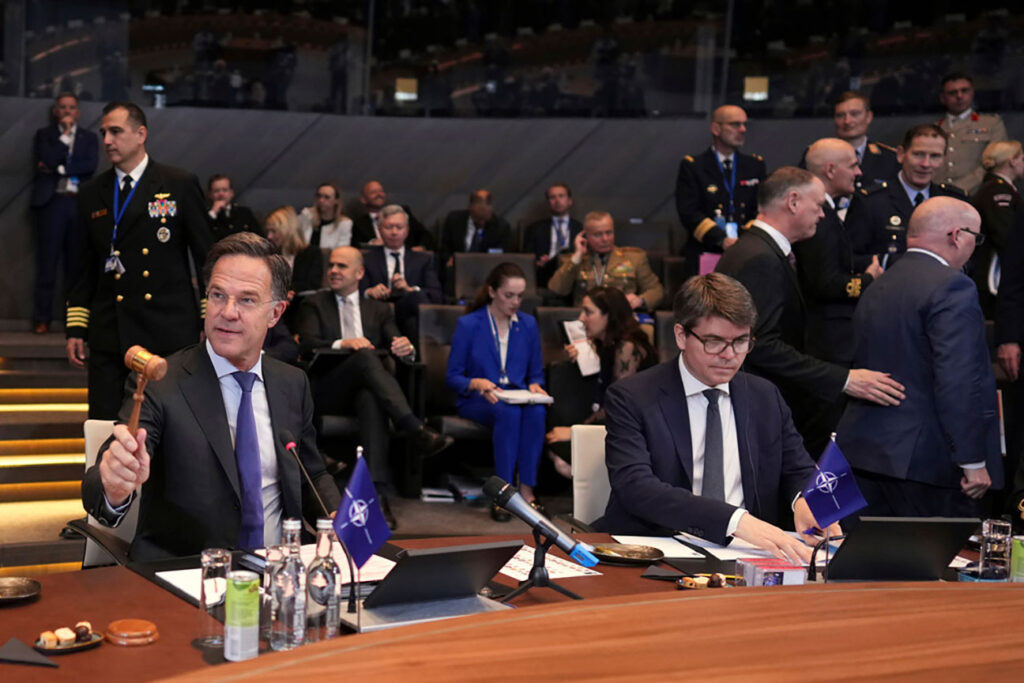NATO Secretary General Mark Rutte, left, bangs a gavel to signify the start of a meeting of NATO defense ministers at NATO headquarters in Brussels on June 5. THE ASSOCIATED PRESS
THE ASSOCIATED PRESS
Most United States allies at NATO endorse a goal to invest 5% of their gross domestic product (GDP) on defense and are ready to ramp up security spending even more, NATO Secretary-General Mark Rutte said in June 2025. “There’s broad support,” Rutte told reporters after chairing a meeting of NATO defense ministers at the alliance’s Brussels headquarters. “We are really close,” he said on June 4. He added that he has “total confidence that we will get there” by the next NATO summit later in June.
Canada and European allies already are investing heavily in their armed forces, as well as on weapons and ammunition since the Russia-Ukraine war began in 2022. At the same time, some have balked at a U.S. request to invest 5% of GDP on defense — 3.5% on core military spending and 1.5% on the roads, bridges, airfields and seaports needed to deploy armies more quickly.
Meeting the old goal
In 2023, as the Russia-Ukraine War entered its second year, NATO leaders agreed to spend at least 2% of GDP on national defense budgets. So far, 22 of the 32 member countries have done so.
The U.S. and NATO allies appear likely to endorse the new goal at a summit in The Hague on June 24-25. The U.S. wants NATO allies to spend at least 5% so the U.S. can focus on security priorities elsewhere, mostly in the Indo-Pacific and its own borders.
The new goal would involve a 1.5% increase over the current 2% goal for defense budgets. It means that all 32 countries would invest the same percentage. The U.S. spends by far more than any other ally. While the two new figures add up to 5%, factoring in improvements to civilian infrastructure so that armies can deploy more quickly significantly changes the basis on which NATO traditionally calculates defense spending.
The seven-year time frame is also short by the alliance’s usual standards. The far more modest 2% target – set after Russia annexed Ukraine’s Crimean Peninsula in 2014 – was meant to be reached over a decade.
U.S. leadership at NATO
The extra spending also will be needed should the U.S. announce a force drawdown in Europe, where around 84,000 U.S. troops are based, leaving European allies to plug security gaps. Asked what the Pentagon’s plans are, Hegseth said: “It would only be responsible for the United States to continually assess our force posture, which is precisely what we’ve done.”
“America can’t be everywhere all the time, nor should we be, and so there are reasons why we have troops in certain places,” he said, offering the assurance that any review would be done “alongside our allies and partners to make sure it’s the right size.”
Endorsing ‘capability targets’
During the meeting, Hegseth and his defense counterparts also approved buying targets to stock up on weapons and military equipment to better defend Europe, the Arctic and the North Atlantic, as part of the U.S. push to ramp up security spending.
The “capability targets” lay out goals for each of the 32 nations to buy priority equipment like air defense systems, long-range missiles, artillery, ammunition, drones and “strategic enablers” such as air-to-air refueling, heavy air transport and logistics. Each nation’s plan is classified, so details are scarce.
NATO assigns the new targets based on a blueprint agreed upon in 2023 — the military organization’s biggest planning shakeup since the Cold War — to defend its territory from an attack by Russia or another major adversary.
Under those plans, NATO would aim to have up to 300,000 troops ready to move to its eastern flank within 30 days. The member countries are assigned roles in defending NATO territory across three major zones — the High North and Atlantic area, a zone north of the Alps and another in southern Europe.
NATO planners believe the targets must be met within 5-10 years, given the speed at which Russia is building its armed forces now, and which would accelerate if any peace agreement is reached to end its war in Ukraine.

